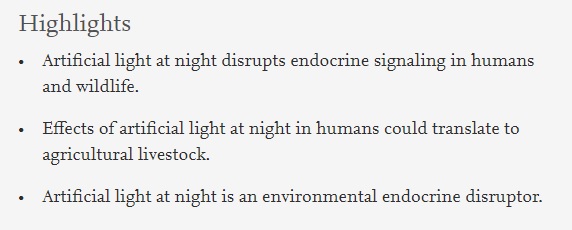Russart KLG, Nelson RJ. Light at night as an environmental endocrine disruptor. Physiol Behav. 2018 Jun 1;190:82-89. doi: 10.1016/j.physbeh.2017.08.029. Epub 2017 Sep 7. PMID: 28870443; PMCID: PMC5839924.

Abstract
Environmental endocrine disruptors (EEDs) are often consequences of human activity; however, the effects of EEDs are not limited to humans. A primary focus over the past ∼30years has been on chemical EEDs, but the repercussions of non-chemical EEDs, such as artificial light at night (LAN), are of increasing interest. The sensitivity of the circadian system to light and the influence of circadian organization on overall physiology and behavior make the system a target for disruption with widespread effects. Indeed, there is increasing evidence for a role of LAN in human health, including disruption of circadian regulation and melatonin signaling, metabolic dysregulation, cancer risk, and disruption of other hormonally-driven systems. These effects are not limited to humans; domesticated animals as well as wildlife are also exposed to LAN, and at risk for disrupted circadian rhythms. Here, we review data that support the role of LAN as an endocrine disruptor in humans to be considered in treatments and lifestyle suggestions. We also present the effects of LAN in other animals, and discuss the potential for ecosystem-wide effects of artificial LAN. This can inform decisions in agricultural practices and urban lighting decisions to avoid unintended outcomes.
Copyright © 2017 Elsevier Inc. All rights reserved.
